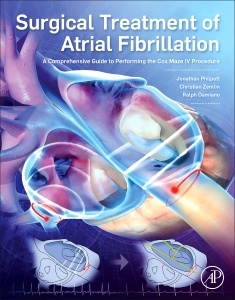Description
Surgical Treatment of Atrial Fibrillation
A Comprehensive Guide to Performing the Cox Maze IV Procedure
Authors: Philpott Jonathan, Zemlin Christian, Damiano Ralph J.
Language: English
Subjects for Surgical Treatment of Atrial Fibrillation:
Keywords
AADs; ablation for atrial fibrillation; AF; Afib; antiarrhythmic drugs; aortic root replacement; atrial fibrillation; atrial fibrillation; Afib; AF; atrial flutter; atrial flutter; iatrogenic atrial flutter; AV node; bicaval cannulation; bipolar RF; Box pulmonary vein isolation; Box PVI; CAB; CABG; cardiac cryo ablation; cardiac cryoablation; cardiac reentry circuits; cardiac surgical procedure; catheter ablation; caval; coronary artery bypass grafts; coronary artery disease; Cox Maze; Cox Maze III; Cox Maze IV; cox maze-I; cox maze-II; cox maze-III; cox maze-IV; Cox-Maze; Cox-Maze IV; cryo; cryoablation; cryosurgery; HRS; HRS AF guidelines; iatrogenic atrial flutter; indications; intraoperative mapping; intraoperative testing; isthmus; left atrial appendage; left atrial appendage amputation; left atrial appendage exclusion; left atrial size; left-sided lesions; lesion; ligament of Marshall; line; macro reentrant circuits; macro reentry circuits; macroreentry circuits; management; Maze; Maze I; Maze II; Maze III; Maze IV; Maze sequencing; Maze; Cox Maze; Maze; Cox Maze; Cox Maze III; Cox Maze IV; Maze III; Maze IV; mitral valve; oblique sinus; outcome tracking; paroxysmal atrial fibrillation; perioperative; permanent atrial fibrillation; persistent atrial fibrillation; postoperative; preoperative; preoperative duration; pulmonary vein isolation; pulmonary vein triggers; pulmonary veins; PVI; radio frequency ablation; radio frequency ablation; RF; radiofrequency; reentry circuits; reentry circuits; macro reentry circuits; reentry circuits; macroreentry circuits; RF; SA node; SA node complex; sequencing strategy; success; success rate; SVC; the intercaval line; thermal ablation tools; transverse sinus; tricuspid; unipolar RF; vertical atriotomy
126.84 €
In Print (Delivery period: 14 days).
Add to cartSupport: Print on demand
Description
/li>Contents
/li>Biography
/li>Comment
/li>
Surgical Treatment of Atrial Fibrillation: A Comprehensive Guide to Performing the Cox-Maze IV Procedure is the first all-inclusive description of this rapidly growing surgery, setting the standard in the field. The Cox-Maze IV procedure is a complex surgery, and its success depends critically on correct execution. With FDA approval, the first RF ablation device for treatment of the Cox-Maze IV procedure has become more important than ever to combine scientific information for the procedure with its connection to human application.
This comprehensive text provides step-by-step instructions from an experienced Cox-Maze IV surgeon and is written in the style of a mentor advising his mentee in the operating room. It contains over a dozen lessons described in detail, with illustrations, photographs and a discussion of possible complications and appropriate ways to deal with them.
Additionally, the book describes sequencing for the surgeries that are typically performed concomitant with the Cox-Maze IV procedure, determining the optimal way to combine surgeries.
Cardiac surgeons, fellows in cardiac surgery, medical students inclined toward cardiac surgery and cardiology researchers will find this book to be of great importance to their work.
1. Foundations and Fundamentals 2. Outcome Tracking Is Critical To Success - And A Mandatory Part Of The Procedure3. Maze Indications, Perioperative Management And Expected Success Rates4. The Art And Science of Making Effective Maze Ablation Lines5. Mastering The Initial Dissection: Making Ablation Easy and Safe6. Overview Of The Right Atrial Lesion Set Of The Maze IV7. The Vertical Atriotomy8. The Intercaval Line9. The Modified and Classic RAA Circuit Interruption Lines10. Tricuspid Caval Isthmus Line11. Overview: Left Atrial Lesion Set Of The Cox Maze IV 12. Box Pulmonary Vein Isolation13. LAA Line and Appendage Amputation / Exclusion14. The Mitral Valve Isthmus Line15. Intra-Operative Testing16. Sequencing Overview & Coronary Artery Bypass Implications17. Sequencing Examples Using the Modified MVI CS Ablation Line Technique
He is a Diplomat of The American Board of Thoracic Surgery, and a Fellow of the American College of Surgeons, a member of the International Society for Heart and Lung Transplantation, and the Heart Rhythm Society.
Dr. Christian Zemlin is the Director of the Cardiac Electrophysiology Lab at Old Dominion University.
He has done basic research on arrhythmia mechanisms and particularly atrial fibrillation for 15 years. He uses voltage-sensitive florescent probed to experimentally study cardiac activity large-scale parallel computer modeling to understand how arrhythmias are initiated and maintained. Other research interests include imaging of tissue structures using optical clearing and confocal; microscopy and the general theory of excitable media.
He has published over 50 peer-reviewed articles (in the category of Medicine), book chapters, and peer-reviewed abstracts. His work receives increased citations year over year from 2005-2014.
Dr. Zemlin is actively collaborating with Dr. Philpott on optimizing aspects of the Cox Maze IV procedure in animal experiments
Dr. Ralph J. Damiano is a pioneer in the area of minimally invasive cardiac surgery. His developmental work on robotically assisted microsurgery for coronary artery bypass grafting (CABG) earned him a ComputerWorld Smithsonian Award in June 1997. Damiano performed the first robotically assisted CABG procedure in North America in December 1998. He completed the first prospective clinical trial in the world on robotically assisted CABG and is the current President of the Internat
- Offers access to video clips that show the steps of the Maze procedure, the techniques involved and the pitfalls that need to be avoided
- Includes coverage of post-procedure management of patients, including assessment, patient follow-up, typical complications and participation in outcome databases
- Provides a detailed discussion of the different energy sources used for the procedure
- Presents guidelines for sequencing and/or combining concomitant surgeries

